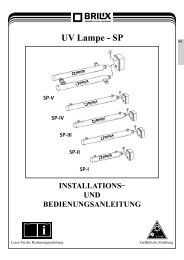swimming pool heat pump installation and user guide - BRILIX.com
swimming pool heat pump installation and user guide - BRILIX.com
swimming pool heat pump installation and user guide - BRILIX.com
Create successful ePaper yourself
Turn your PDF publications into a flip-book with our unique Google optimized e-Paper software.
6. Do not use the <strong>heat</strong> <strong>pump</strong> if it was flooded. Immediately contact a qualified specialist to check the <strong>pump</strong><br />
<strong>and</strong> repair it if necessary.<br />
Condensation may occur when the <strong>heat</strong> <strong>pump</strong> is running. This condensation may drain away from the aperture in<br />
the bottom of the unit. The amount of condensed water increases if atmospheric moisture is high. Remove any pollutants,<br />
which could prevent drainage of condensation.<br />
When the unit is running, 10 to 20 litres of condensed water may be produced. If more water than this is created, stop<br />
the <strong>heat</strong> <strong>pump</strong> <strong>and</strong> wait for one hour before checking for leaks in the pipes.<br />
IMPORTANT: A quick method of checking whether water flowing from the condensation pipe really is condensed,<br />
is to stop the unit <strong>and</strong> leave the <strong>swimming</strong> <strong>pool</strong> <strong>pump</strong> in operation. If water stops flowing from the condensation<br />
pipe, it is condensed. AN EVEN FASTER METHOD is TESTING FOR THE PRESENCE OF CHLORINE IN THE<br />
water <strong>com</strong>ing from the pipe. If no chlorine is found, the water being drained is the result of condensation.<br />
Also make sure that the air intake <strong>and</strong> outlet is clear. Prevent waste air from immediately returning to<br />
the unit via the intake.<br />
XI. Problem solving<br />
Incorrect fitting could lead to electrical discharge, which could lead to fatal or serious injury to <strong>user</strong>s of<br />
the <strong>swimming</strong> <strong>pool</strong> as a result of electric shock <strong>and</strong> could also cause damage to property.<br />
DO NOT ATTEMPT to change the internal configuration of the <strong>heat</strong> <strong>pump</strong>.<br />
1. In order to avoid injury, make sure that your h<strong>and</strong>s <strong>and</strong> hair do not <strong>com</strong>e into the vicinity of the ventilator<br />
blades.<br />
2. If you are not familiar with filtration systems <strong>and</strong> the <strong>heat</strong> <strong>pump</strong> in your <strong>swimming</strong> <strong>pool</strong>:<br />
a. Do not attempt to set or adjust equipment without advice from your dealer or a specialist supplier<br />
of treatment <strong>and</strong> air-conditioning equipment.<br />
b. Before using the equipment for the first time, adjusting or setting the unit, read the whole <strong>installation</strong><br />
<strong>and</strong> operating instructions.<br />
NOTE: Before <strong>com</strong>mencing maintenance or repairs, disconnect the power supply.Note that only authorized<br />
person can provide maintanence of any electric device.<br />
IMPORTANT: If a defect cannot be resolved immediately, in order to analyse the problem itself, it will be<br />
necessary to know details of the message (error code), which is shown on the display of the controller, as<br />
well as the values for the settings (parameters 0–A for the LED display) <strong>and</strong> for the status of the <strong>heat</strong> <strong>pump</strong><br />
(ambient air temperature, temperature of the in<strong>com</strong>ing/outgoing water <strong>and</strong> coil temperature) directly before<br />
the defect or, if possible, directly after it.<br />
The following pages contain a summary of various types of problems, which may occur, together with<br />
instructions for their resolution.<br />
17<br />
EN






